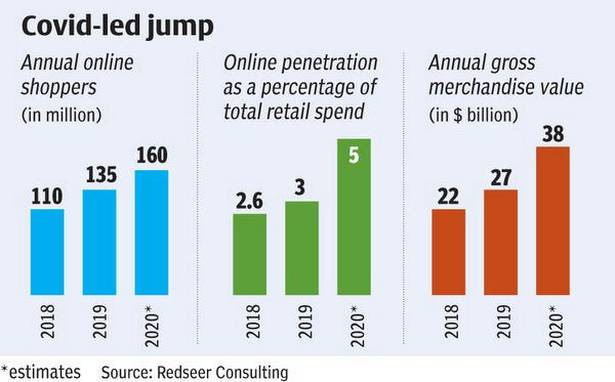This newsletter is a a deep dive into how anyone can start an Ecommerce store as a side hustle.
The Indian Dream is a weekly newsletter that gives you latest Business Ideas, Opportunities and Trends direct to your inbox. Join 1,500+ other entrepreneurs looking for their next big business!
I built an ecommerce store 2 years ago. It does $1,000 - $2,000 of revenue each month with minimal effort. Setting it up was easy - I just bought a Shopify theme for $200, set up my supplier relations, set up the entire backend and now I just let the store run itself.
It’s a side hustle which taught me a lot of important skills - digital marketing, website building, shipping & logistics & much more.
Ecommerce stores are an easy way to dip your toes into the deep ocean of entrepreneurship - at a small scale, they’re easy to set up and don’t need too many resources.
What is an Ecommerce Store?
An ecommerce store is any website where you can buy products - physical or digital. Amazon and Flipkart are ecommerce marketplaces while individual stores built on Shopify are independant ecommerce stores.
In this article, we’re going to focus on building an independent ecommerce store. We’ll cover Amazon FBA in a future side hustle article.
Ecommerce Stores as a Side Hustle
I love the idea of ecommerce stores as a side hustle.
You learn the basics of entrepreneurship including setting up supply chains, marketing, digital strategies, etc.
Easy to set up and doesn’t take up much time.
Low investment - shouldn’t be more than a few hundred dollars if you do dropshipping.
Can sell to the world! My store is focused on US customer.
Easy to scale up if it does well.
Lastly, Ecommerce is absolutely booming in India right now because of the pandemic.
And it’s only penetrated 5% of total retail spend in India.
As the market continues to grow fast, there will be space opening up for small, niche ecommerce stores who can take a small piece of the large pie.
Types of Ecommerce Stores
You need to decide the type of store that works best for you depending on your customer type and the amount of time & capital you want to invest into the venture.
Based on Customer Type
Direct to Consumer (D2C) - You target the end customer directly without anybody in between.
Wholesaling or B2B - B2B ecommerce is booming right now. Faire, a B2B wholesale marketplace, has raised $436 million so far. My sister has a flourishing business focused on wholesale B2B ecommerce.
Based on Supply Chain
Dropshipping - The product is made and shipped by the manufacturer. You hold no inventory and minimal risk.
Since this is the easiest route, it is also the most popular.
Unless you are uniquely talented at marketing/branding, there’s no reason another store won’t tie up with the same manufacturer -> it just ends in a price war.
My opinion - if you want to stay capital light, start with dropshipping but you’ll always have to be on the lookout for the next big thing.
With Inventory and/or Manufacturing - Either you or someone else manufactures the product and you store them at your home/warehouse.
Based on Delivery Type
Subscription Model - Very popular a few years ago but still going strong in certain sectors. This model ensures monthly revenue which is fantastic.
Well branded subscription boxes can also work well when directed at a specific niche. Check out FabFitFun.
Digital Products - Digital art, books, or other products delivered directly to someone’s inbox. This works best as an audience first product because it usually involves building trust/loyalty before the purchase.
Who should start an E-Commerce Store?
You’re Detail Oriented & Enjoy Operations - You’re the type of person who likes to get their hands dirty in the details of shipment processing, pricing, sampling, etc. You have to do this all on your own so you need to go into the nitty gritty.
You want to Learn Digital Marketing - What better way to learn Digital Marketing than building your own website? You’ll have to teach yourself everything from SEO to Performance Marketing. This will be a crash course in Digital Marketing.
You’re Already a Niche Influencer - If you have an audience who already follow you for beauty - why not start a cosmetics dropshipping business? You’ve put in the hard work into building your audience - this is an easy way to monetise.
Full Scale Entrepreneurship is on the Horizon - Starting an ecommerce store is a cheap way to learn most of the basics of entrepreneurship. You’ll deal with irritated customers, supplier issues, quality checks and much more without the risks of a larger business.
Starting Your Own E-Commerce Store
Step 1: Pick Your Niche
I should tattoo this phrase on my arm.
Unless you plan to throw a bunch of money into marketing, a generic store will not stand out and you’ll have to fight with the likes of Amazon & Flipkart.
This step will require a considerable amount of market research - you can use the steps for keyword research from this article or Amazon keyword research tools.
For example, if I want to get into the pet industry, I could sell generic dog toys - everyone does that. Or I can focus on dog toys for dogs who are high energy and food focused. This is a problem I face everyday - if somebody gave me a good solution to it, I wouldn’t stop talking about it.
Bewakoof is now a 300cr business because they focused on quirky t-shirts - this helped them grow their user base and create a solid niche.
Option: Buy an Existing E-Commerce Store
There are plenty of platforms such as Flippa, Empire Flippers, Microacquire, etc. which list ecommerce stores for sale. Buying an existing store helps you skip the first 4 steps and go directly to promoting the store.
You can expect a price multiple of ~1.5 - 2x of annual profit - this means a recovery of period of 1.5 - 2 years on your investment. Some websites/stores have higher profit multiples.
Step 2: Figure out the Supply Chains
Step 2.1: Find Suppliers - Trade India, India Mart, Alibaba will be your best friends.
Step 2.2: Get Samples & Set Quality Standards
Step 2.3: Finalise Supplier
Step 2.4: Set Pricing - 100% - 300% markup is the standard for retail
Step 2.5: Figure out Delivery Method and Return Policies
For India - Dehlivery, Shiprocket, etc.
International couriers can get quite expensive, more than 50% of costs in some cases. Shop around, talk to as many companies as possible.
Return policies have a huge impact on customer purchases and your own profitability - do your research before deciding anything.
I got an email about a return while writing this article 🤦🏽♂️
Step 2.6: Set Delivery Pricing
Quite easy to get wrong for international couriers and you can make losses on each delivery without realising it.
Costing is usually done according to weight or volume of the package - make sure you know the exact weight and dimensions of each product.
Step 2.7: Set Delivery Times - the easiest way to get customer complaints if not set correctly.
Dropshipping: Get weekly inventory sheet from your supplier & update in your backend.
Inventory Model: Place first order with the supplier and set a minimum restock level.
Step 3: Pick Your Platform
The rise of ecommerce was first because of massive marketplaces like Amazon & Flipkart. In the last few years, there’s been a proliferation of tools that let you easily set up your own ecommerce stores without any coding. Shopify is touted to be the anti-Amazon that can take on the $1.7 trillion giant.
Many no code/low code options to build your own website:
Shopify - ~$30/mo, has fantastic templates for sale, lots of app integrations & pretty easy to use overall.
BigCommerce - ~$30/mo, not as many templates or app integrations, Shopify’s biggest competitor.
WooCommerce - Free but a lot of extra costs like WordPress, hosting, etc.. Also, it’s based on WordPress so it’ll require some coding.
SquareSpace - ~$26/mo, pretty decent tool, no coding required.
Step 4: Build out the Website with SEO & Plugins in mind
Building the website is pretty straightforward - you have to build the homepage, add photos and descriptions of all your products, build out the backend including automatic emails, payment integrations - that’s most of it.
Tip: keep SEO in mind throughout the entire website building process. If you don’t know much about SEO, take a course on Coursera or Udemy. If you build SEO into the bones of your website, it’ll pay you dividends over the long run.
Also, automate as much as possible from the start. Plugins can help with this - for example, Klaviyo can be used to send a series of emails (drip marketing) to anyone who signs up to your website. Spend time on the Shopify App Store and figure out the best apps for your own store.
P.s. if you have a requirement that can’t be solved by an existing Shopify app, that could be an idea for a Micro SaaS business which is another great side hustle.
Step 5: Performance Marketing for your E-Commerce Store
Facebook and Google Ads.
These are a black hole of money but they can be easily scaled up and down based on your own time/money assets at the time.
As per our conversations with Himanshu Arora from Social Panga - as the algorithm and you keep optimising the ads and audiences, you’ll first get to 1x revenue on your ad spend. This means that spending Rs. 1,000 on FB ads and getting Rs. 1,000 in revenue from those ads. Based on the industry and your own marketing skills, you can eventually expect to get to 3-5x revenue for your performance marketing spends.
Tip: As you build your email list from these performance marketing efforts, make sure to regularly email your subscribers. The best email marketing campaigns are those that focus more on providing value than trying to constantly sell. Write a bunch of useful articles and use Klaviyo to automate a drip marketing campaign for anyone who signs on.
Step 6: Influencer Marketing (Niche influencers are the best ROI)
As we wrote in the last email, Niche Influencers have a huge impact on purchase decisions.
“82 percent of consumers … reported they were highly likely to follow a recommendation made by a micro influencer.”
The other advantage of Niche Influencers is that they generally don’t ask for payments. However, they expect to get a sample of the product for free.
The way to execute this campaign would be to get as many nano influencers from a certain niche as possible to post about your product in a short period of time. It takes multiple touchpoints with customers to get them through the AIDA cycle (we spoke about it in detail here). Seeing the brand being promoted by multiple influencers whom they trust can lead a consumer from Awareness -> Interest -> Desire -> Action.
Step 7: Content Marketing + SEO -> Long Term Growth
“Content marketing is a form of marketing focused on creating, publishing, and distributing content”. Generally, this involves blog posts, YouTube videos, Instagram pages and other forms of content creation.
Regular content creation, especially blog posts, can have a huge impact on your SEO over a long period of time. As the amount of content on your website grows, and as your domain name ages, your website will slowly start ranking higher on Google.
You can also work on a long term strategy of building backlinks (improves SEO) where you write a guest post once a month on someone else’s blog so that they link back to you.
SEO is the foundation of long term growth for an ecommerce business - focus on it for a few years and you’ll be doing enough business to quit your main hustle.
Bonus Step: Iterate the Checkout Process to improve Conversion Rates
There are many factors that lead to potential customers dropping off after adding your products to their cart (cart abandonment).
There are many ways to improve checkout conversion rates including tricks like abandoned cart emails, discount coupon, easier checkout, etc.. As your store continues to grow, iterate on different ways to improve the checkout process so that you can keep improving your conversion rate. An improvement from 1% to 2% conversion rates will double your revenue.
The Danger of Ecommerce Stores
Unless you innovate on the product or branding - there is little to no differentiation between you and your competitors. Since it is so easy to set up these stores - as soon as you start becoming successful, you will have ample competition in any niche that you choose to serve.
This is why I focused so much on SEO & other kinds of marketing - these will be your differentiating factors that will drive people to your store.
Remember, ecommerce is still only 5% of the total retail spend in India - it’s going to grow like crazy in the upcoming years and you should try to get a piece of it.
If you liked this newsletter - please share it with your friends!










